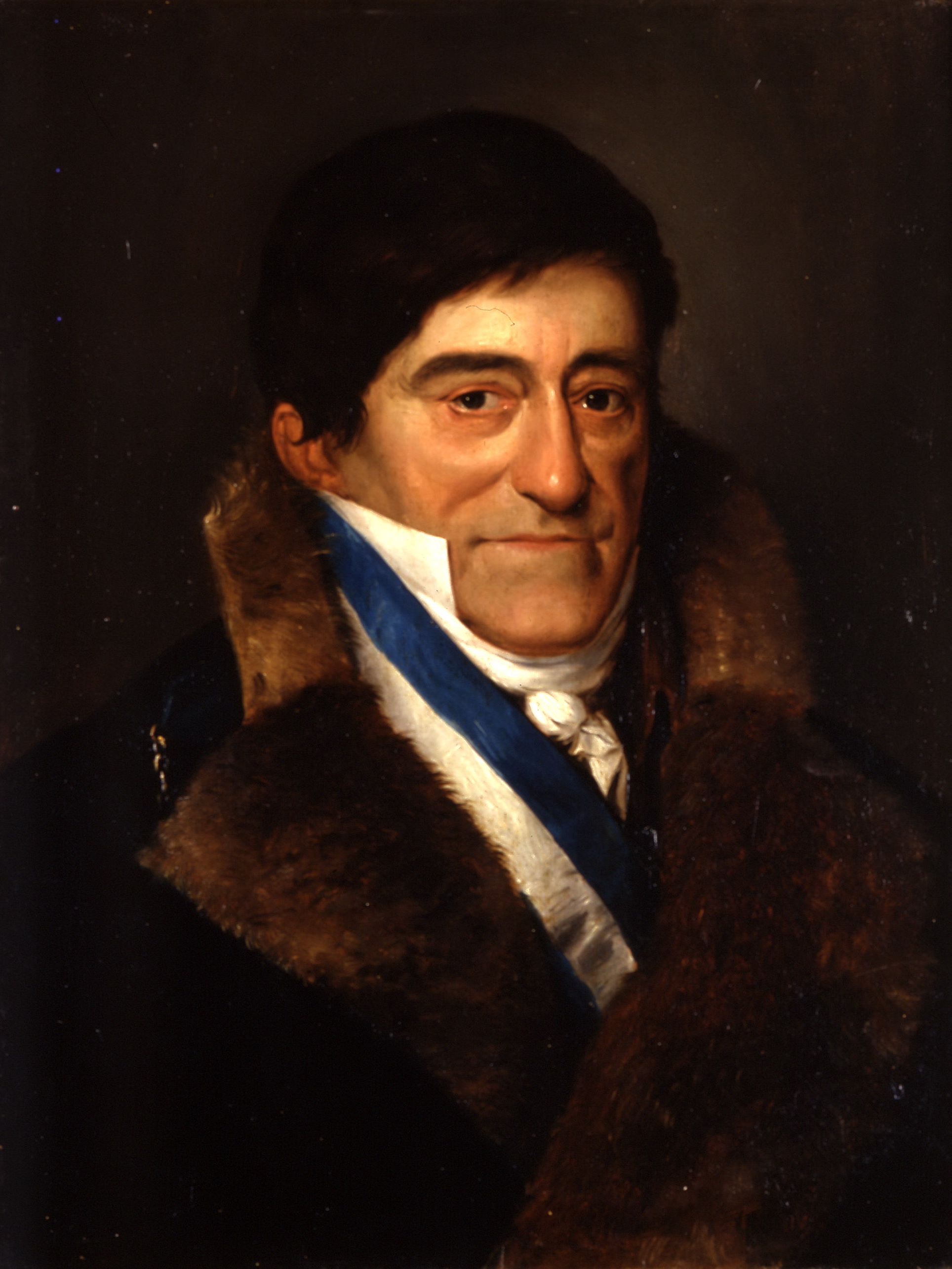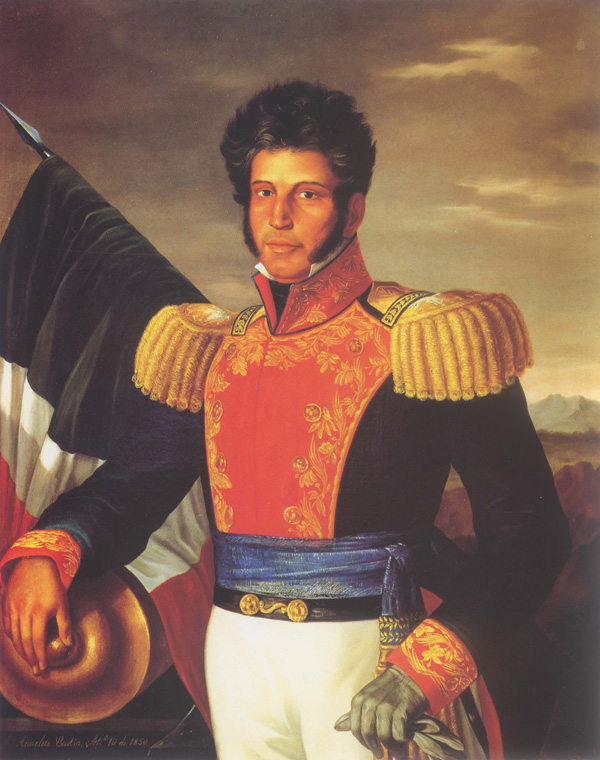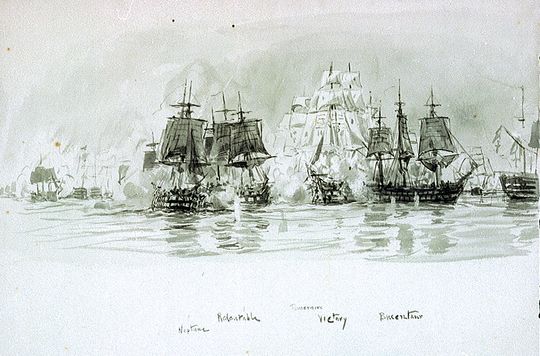|
Juan Ruiz De Apodaca
Juan José Ruiz de Apodaca y Eliza, 1st Count of Venadito, OIC, OSH, KOC (3 February 1754, Cadiz, Spain – 11 January 1835, Madrid, Spain) was a Spanish naval officer and viceroy of New Spain from 20 September 1816 to 5 July 1821, during Mexico's War of Independence. Military career Ruiz de Apodaca was born in Cádiz into a family of renowned Basque merchants. He entered the navy in 1767 and took part in the campaign against Algerian pirates. In 1770 he was promoted to the rank of ensign. He was in Peru from 1770 to 1778 and England in 1779. From 1781 to 1790 he was a captain, in charge of ships of the line, and afterward he was in charge of the reconstruction of the harbor at Tarragona. In October 1802 he was named commandant of the arsenal at Cadiz. Now in command of a squadron, he made major improvements at Cadiz. When the French invaded Spain, he took command of the remnants of a Spanish fleet, which had been largely captured or destroyed in the Battle of Trafalgar ... [...More Info...] [...Related Items...] OR: [Wikipedia] [Google] [Baidu] |
The Most Excellent
The Most Excellent (Spanish language, Spanish: ''Excelentísimo Señor'' (male) or ''Excelentísima Señora'' (female), literally "Most Excellent Sir/Madam") is an honorific prefix that is traditionally applied to certain people in Spain and certain Spanish-speaking countries. Following Spanish tradition, it is an ''ex officio'' style (the holder has it as long as they remain in office, in the most important positions of state) and is used in written documents and very formal occasions. The prefix is similar (but not equal) to that of "Excellency, His/Her Excellency", but in the 19th century "The Most Excellent" began to replace the former. The use of the prefix Excellency was re-introduced in Francoist Spain by ''Generalísimo'' Francisco Franco himself, who was formally styled as ''Military career and honours of Francisco Franco, Su Excelencia el Jefe del Estado'' ("His Excellency The Head of State"), while his ministers and senior government officials continued using the prefix ... [...More Info...] [...Related Items...] OR: [Wikipedia] [Google] [Baidu] |
Mexico
Mexico (Spanish: México), officially the United Mexican States, is a country in the southern portion of North America. It is bordered to the north by the United States; to the south and west by the Pacific Ocean; to the southeast by Guatemala, Belize, and the Caribbean Sea; and to the east by the Gulf of Mexico. Mexico covers ,Mexico ''''. . making it the world's 13th-largest country by are ... [...More Info...] [...Related Items...] OR: [Wikipedia] [Google] [Baidu] |
Nicolás Bravo
Nicolás Bravo (10 September 1786 – 22 April 1854) was a Mexican soldier and politician who first distinguished himself during the Mexican War of Independence. He was Mexico's first vice-president though while holding this office Bravo would try to overthrow President Guadalupe Victoria through the Plan of Montaño in 1827. His revolt failed and in part due to the services Bravo had provided the nation during the War of Independence, he was allowed to live, but nonetheless exiled. Bravo would return to the country and later go on to serve as interim president of Mexico three separate times in 1839, 1842, and 1846. During his second presidency he oversaw the transition of the Centralist Republic of Mexico to a new constitution as part of the Bases of Tacubaya. During the Mexican-American War he commanded the Mexican forces at the Battle of Chapultepec. Early life Nicolás Bravo was born on September 10, 1786, in Chilpancingo, to a wealthy family. After the War of Mexica ... [...More Info...] [...Related Items...] OR: [Wikipedia] [Google] [Baidu] |
Guadalupe Victoria
Guadalupe Victoria (; 29 September 178621 March 1843), born José Miguel Ramón Adaucto Fernández y Félix, was a Mexican general and political leader who fought for independence against the Spanish Empire in the Mexican War of Independence. He was a deputy in the Mexican Chamber of Deputies (Mexico), Chamber of Deputies for Durango and a member of the Supreme Executive Power following the downfall of the First Mexican Empire. After the adoption of the 1824 Constitution of Mexico, Constitution of 1824, Victoria was elected as the first President of Mexico, president of the First Mexican Republic, United Mexican States. As president he established diplomatic relations with the United Kingdom, the United States, the Federal Republic of Central America, and Gran Colombia. He also founded the National Museum, promoted education, and ratified the border with the United States of America. He decreed the expulsion of the Spaniards remaining in the country and defeated the last Spanish ... [...More Info...] [...Related Items...] OR: [Wikipedia] [Google] [Baidu] |
Vicente Guerrero
Vicente Ramón Guerrero (; baptized August 10, 1782 – February 14, 1831) was one of the leading revolutionary generals of the Mexican War of Independence. He fought against Spain for independence in the early 19th century, and later served as the second president of Mexico. He abolished slavery on a national level during his brief term as president. Guerrero was deposed in a rebellion under Vice-President Anastasio Bustamante. Early life UR Guerrero was born in Tixtla, a town 100 kilometers inland from the port of Acapulco, in the Sierra Madre del Sur; his parents were María Guadalupe Rodríguez Saldaña, and Juan Pedro Guerrero. His father's family included landlords, wealthy farmers, and traders with broad business connections in the south, members of the Spanish militia, and gun and cannon makers. In his youth, he worked for his father's freight business that used mules for transport, a prosperous business during this time. His travels took him to different parts of Mexico ... [...More Info...] [...Related Items...] OR: [Wikipedia] [Google] [Baidu] |
Royal And Military Order Of San Hermenegildo
The Royal and Military Order of Saint Hermenegild ( es, Real y Militar Orden de San Hermenegildo) is both a general military honor and a legion created by Ferdinand VII of Spain on 28 November 1814. The Royal and Military Order of Saint Hermenegild is a military award, distinction of the Spain, Spanish Cavalry created by Ferdinand VII of Spain at the conclusion of the Peninsular War, Spanish War of Independence in 1814. The purpose of the Order was to serve as a maximum means of reward for those soldiers who exceeded their military obligations and fought on, surpassing their suffering in battle, and who thus would serve as examples of bravery to His Spanish Majesty's armies. Given the desire of the King to create a distinction of extraordinary rank, comparable to others traditional honours, it was decided to put the Order under the Patronage of Hermenegild, Saint Hermenegild, who was the Visigoth King of Seville who was martyred in defence of the Christian faith in the sixth cen ... [...More Info...] [...Related Items...] OR: [Wikipedia] [Google] [Baidu] |
Spanish Florida
Spanish Florida ( es, La Florida) was the first major European land claim and attempted settlement in North America during the European Age of Discovery. ''La Florida'' formed part of the Captaincy General of Cuba, the Viceroyalty of New Spain, and the Spanish Empire during Spanish colonization of the Americas. While its boundaries were never clearly or formally defined, the territory was initially much larger than the present-day state of Florida, extending over much of what is now the southeastern United States, including all of present-day Florida plus portions of Georgia, Alabama, Mississippi, North Carolina, South Carolina, and Louisiana. Spain's claim to this vast area was based on several wide-ranging expeditions mounted during the 16th century. A number of missions, settlements, and small forts existed in the 16th and to a lesser extent in the 17th century; they were eventually abandoned due to pressure from the expanding English and French colonial settlements, the collap ... [...More Info...] [...Related Items...] OR: [Wikipedia] [Google] [Baidu] |
Capture Of Rosily Squadron
The Capture of the Rosily Squadron, also known as the Battle of Poza de Santa Isabel, took place on 14 June 1808, in Cádiz, Spain, during the uprising against the French invaders. Five French ships of the line and a frigate were in the port, having remained there under blockade since the Battle of Trafalgar nearly three years earlier. After an engagement with the Spanish lasting five days, French Admiral François Étienne de Rosily-Mesros surrendered his entire squadron with the four thousand seamen then on board. Background The Spanish conventional warfare had started with the Battles of El Bruch. The spring of 1808 saw a deterioration in relations between erstwhile allies Spain and France, culminating in rebellions against the Spanish king Charles IV, leading to a French occupation and the placing of Joseph Bonaparte on the Spanish throne. Under difficult circumstances, Rosily endeavoured to gain enough time for the arrival at Cádiz of French troops which had been ... [...More Info...] [...Related Items...] OR: [Wikipedia] [Google] [Baidu] |
Battle Of Trafalgar
The Battle of Trafalgar (21 October 1805) was a naval engagement between the British Royal Navy and the combined fleets of the French and Spanish Navies during the War of the Third Coalition (August–December 1805) of the Napoleonic Wars (1803–1815). As part of Napoleon's plans to invade England, the French and Spanish fleets combined to take control of the English Channel and provide the Grande Armée safe passage. The allied fleet, under the command of the French admiral, Pierre-Charles Villeneuve, sailed from the port of Cádiz in the south of Spain on 18 October 1805. They encountered the British fleet under Lord Nelson, recently assembled to meet this threat, in the Atlantic Ocean along the southwest coast of Spain, off Cape Trafalgar. Nelson was outnumbered, with 27 British ships of the line to 33 allied ships including the largest warship in either fleet, the Spanish ''Santísima Trinidad''. To address this imbalance, Nelson sailed his fleet directly at the allied ba ... [...More Info...] [...Related Items...] OR: [Wikipedia] [Google] [Baidu] |
Tarragona
Tarragona (, ; Phoenician: ''Tarqon''; la, Tarraco) is a port city located in northeast Spain on the Costa Daurada by the Mediterranean Sea. Founded before the fifth century BC, it is the capital of the Province of Tarragona, and part of Tarragonès and Catalonia. Geographically, it is bordered on the north by the Province of Barcelona and the Province of Lleida. The city has a population of 201,199 (2014). History Origins One Catalan legend holds that Tarragona was named for ''Tarraho'', eldest son of Tubal in c. 2407 BC; another (derived from Strabo and Megasthenes) attributes the name to ' Tearcon the Ethiopian', a seventh-century BC pharaoh who campaigned in Spain. The real founding date of Tarragona is unknown. The city may have begun as an Iberian town called or , named for the Iberian tribe of the region, the Cossetans, though the identification of Tarragona with Kesse is not certain. William Smith suggests that the city was probably founded by the Phoenicians, w ... [...More Info...] [...Related Items...] OR: [Wikipedia] [Google] [Baidu] |
Ship Of The Line
A ship of the line was a type of naval warship constructed during the Age of Sail from the 17th century to the mid-19th century. The ship of the line was designed for the naval tactic known as the line of battle, which depended on the two columns of opposing warships maneuvering to volley fire with the cannons along their broadsides. In conflicts where opposing ships were both able to fire from their broadsides, the opponent with more cannons firingand therefore more firepowertypically had an advantage. Since these engagements were almost invariably won by the heaviest ships carrying more of the most powerful guns, the natural progression was to build sailing vessels that were the largest and most powerful of their time. From the end of the 1840s, the introduction of steam power brought less dependence on the wind in battle and led to the construction of screw-driven wooden-hulled ships of the line; a number of purely sail-powered ships were converted to this propulsion mech ... [...More Info...] [...Related Items...] OR: [Wikipedia] [Google] [Baidu] |







